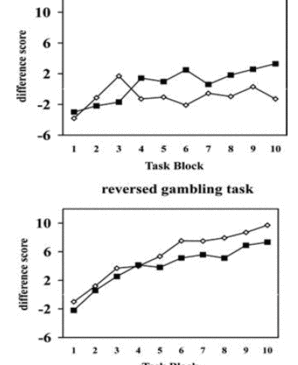According to DSM-IV, disordered gambling is an impulse disorder (American Psychiatric Association, 1994). Research has found relationships between poor impulse control and gambling problems (Blaszczynski & Steel, 1998; Chambers & Potenza, 2003; Vitaro, Arsenault, & Tremblay, 1999), and heavy gamblers often display impaired decision-making characteristics that are common among people with high impulsivity (Alessi & Petry, 2003). Though the etiology of impulsive decision-making is still unknown, two primary possibilities exist: (1) neurological hypersensitivity to reward (Chambers, Taylor, & Potenza, 2003; Holden, 2001), or (2) a failure or inability to consider and evaluate future consequences (Bechara, 2003). Though these mechanisms are unlikely to be independent, their relative importance and causal influence may differ. Until recently, researchers had not scientifically compared the role of hypersensitivity and future insensitivity in impulsive decision-making. In this week’s WAGER, we review an article by Crone and her colleagues (Crone, Vendel, & van der Molen, 2003) that investigates whether cognitive disinhibition – a trait characterized by sensation seeking and impulsive decision-making – primarily involves oversensitivity to reward or insensitivity to future consequences.
Crone et al. (2003) tested 257 undergraduate students for cognitive disinhibition using the disinhibition subscale of the Zuckerman Sensation Seeking Scale (Zuckerman, Eysenck, & Eysenck, 1978). Willing members of the upper 20% (n = 14) and lower 20% (n =21) of the distribution of disinhibition participated in this study. These 35 participants completed two computerized versions of the Iowa Card Gambling Task (ICGT). The standard version, which is often used in decision-making and inhibition research, presents participants with four possible selections (e.g., decks of cards or closed doors). Two of the options produce relatively large rewards upon each selection, but unpredictable large losses across a set of selections resulting in a net loss. The other two produce relatively small rewards upon each selection, but smaller long-term unpredictable losses resulting in a net gain. Because poor performance on this task may indicate either sensitivity to the immediate reward or failure to consider long-term outcomes (Bechara, Damasio, Damasio, & Anderson, 1994), Crone et al. included a reversed ICGT, in which costs were presented immediately and rewards unpredictably(1). Thus, if participants were sensitive to reward, they would perform poorly on the standard task but normally on the reversed task. If they were insensitive to future outcomes, they would perform poorly on both tasks.
Figure 1. Task performance (advantageous choices – disadvantage choices) of cognitively disinhibited and inhibited participants on standard and reversed ICGT across trials (Crone et al., 2003).
Overall, participants performed better in the reversed task than in the standard task, indicating that reward considerations might place undue influence over most individual’s decision-making. Cognitive disinhibition interacted significantly with task, F(1,83) = 4.25, p < .05. Highly disinhibited participants performed worse than their inhibited counterparts on the standard task, but performed just as well on the reversed task. These results indicate that cognitive disinhibition involves oversensitivity to reward more than insensitivity to future consequences.
There are two limitations to this study. First, the small number of subjects raises questions about the generalizability and stability of the findings. Second, the study relied on a single self-report measure of cognitive disinhibition to divide participants into groups. It might be that the sensitivity to reward observed in this study reflects more about the aspects of disinhibition included in the sensation seeking measure employed than the sensitivities of disinhibited individuals in general. Despite these concerns, Crone et al.’s findings further our understanding of the cognitive mechanisms involved in impulsive behaviors and help distinguish between two proposed aspects of impulsivity. Even if the disinhibition scale does not measure all aspects of cognitive impulsivity, the results make a strong case that scientists and clinicians need to consider sensitivity to reward and insensitivity to future consequences separately as possible dimensions of disinhibition and impulsive decision-making. Applied to gambling studies, Crone et al.’s results add behavioral confirmation to recent neuroscience studies (see WAGERs 8(30), 8(31), 8(32), and 8(33)) that indicate deficits in the brain’s reward pathways as common mechanisms involved across behavioral and substance addictions.
Comments on this article can be addressed to Sara Nelson.
Notes
1. In this reversed task, two options resulted in relative large costs initially, but even larger gains spread unpredictably across several trials. The two other options produced small costs initially, but even smaller unpredictable gains across selections.
References
Alessi, S. M., & Petry, N. M. (2003). Pathological gambling severity is associated with impulsivity in a delay discounting procedure. Behavioural Processes, 64, 345-354.
American Psychiatric Association. (1994). DSM-IV: Diagnostic and statistical manual of mental disorders (Fourth ed.). Washington, D.C.: American Psychiatric Association.
Bechara, A. (2003). Risky business: Emotion, decision-making, and addiction. Journal of Gambling Studies, 19(1), 23-51.
Bechara, A., Damasio, A. R., Damasio, H., & Anderson, S. W. (1994). Insensitivity to future consequences following damage to human prefrontal cortex. Cognition, 50, 7-15.
Blaszczynski, A., & Steel, Z. (1998). Personality disorders among pathological gamblers. Journal of Gambling Studies, 14(1), 51-71.
Chambers, R. A., & Potenza, M. N. (2003). Neurodevelopment, impulsivity, and adolescent gambling. Journal of Gambling Studies, 19(1), 53-84.
Chambers, R. A., Taylor, J. R., & Potenza, M. N. (2003). Developmental neurocircuitry of motivation in
adolescence: A critical period of addiction vulnerability. American Journal of Psychiatry, 160(6), 1041-1052.
Crone, E. A., Vendel, I., & van der Molen, M. W. (2003). Decision-making in disinhibited adolescents and adults: Insensitivity to future consequences or driven by immediate reward? Personality and Individual Differences, 35, 1625-1641.
Holden, C. (2001). "Behavioral" addictions: Do they exist? Science, 294, 980-982.
Potenza, M. N. (2001). The neurobiology of pathological gambling. Seminars in Clinical Neuropsychiatry, 6, 217-226.
Vitaro, F., Arsenault, L., & Tremblay, R. E. (1999). Impulsivity predicts problem gambling in low SES adolescent males. Addiction, 94(4), 565-575.
Zuckerman, M., Eysenck, S., & Eysenck, H. J. (1978). Sensation seeking in England and America:Cross-cultural, age and sex comparisons. Journal of Consulting and Clinical Psychology, 46(1), 139-149.





